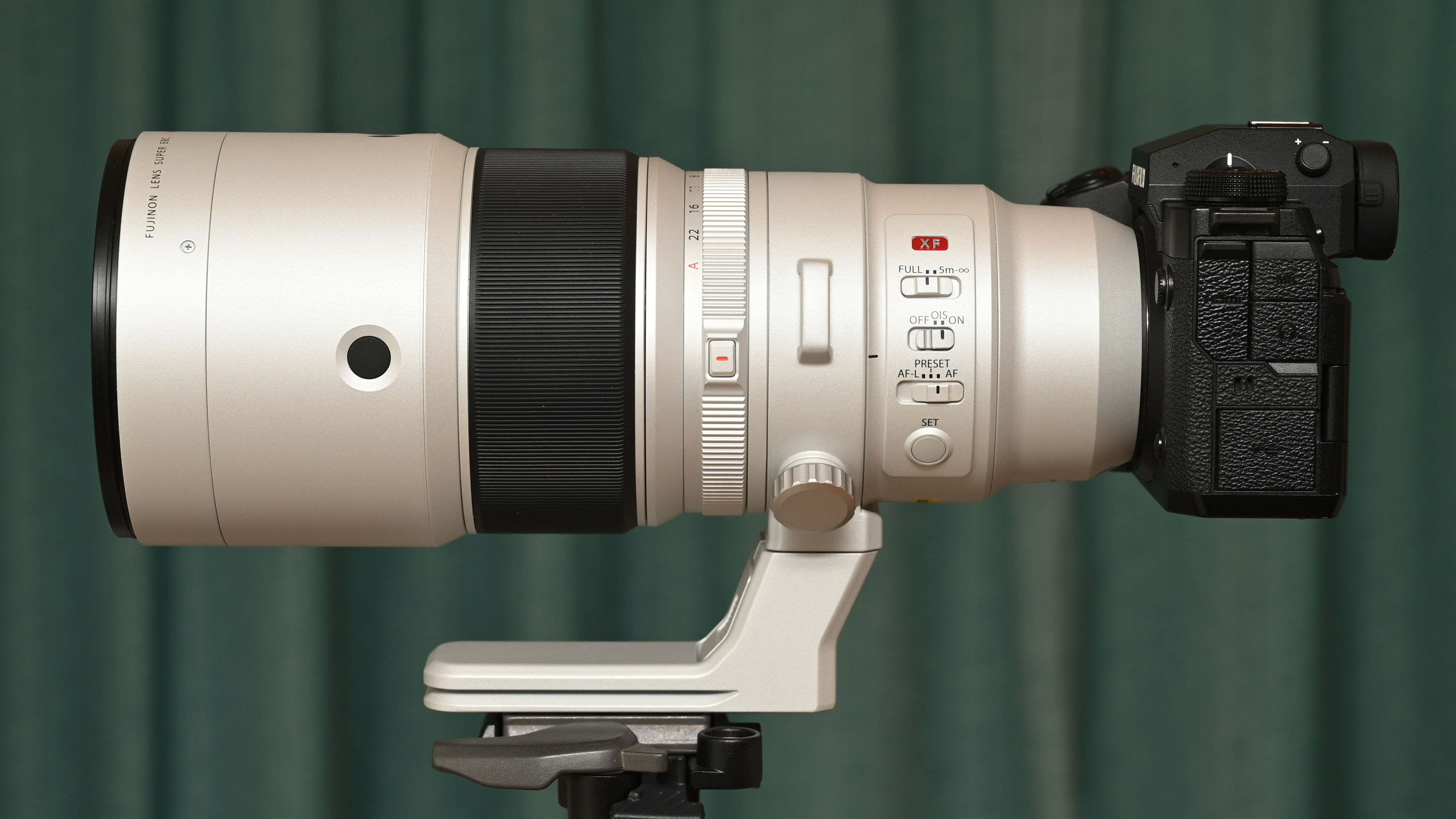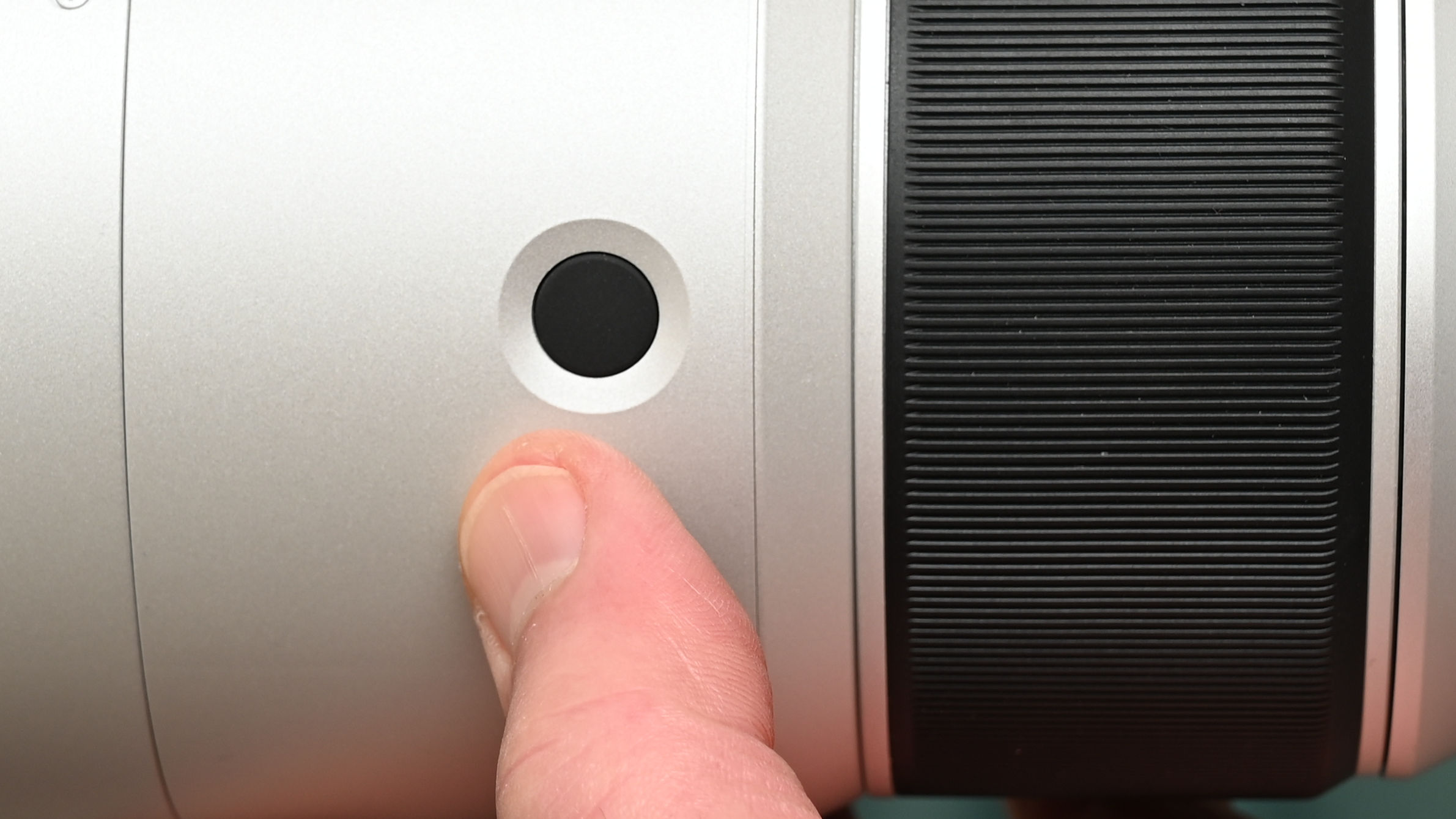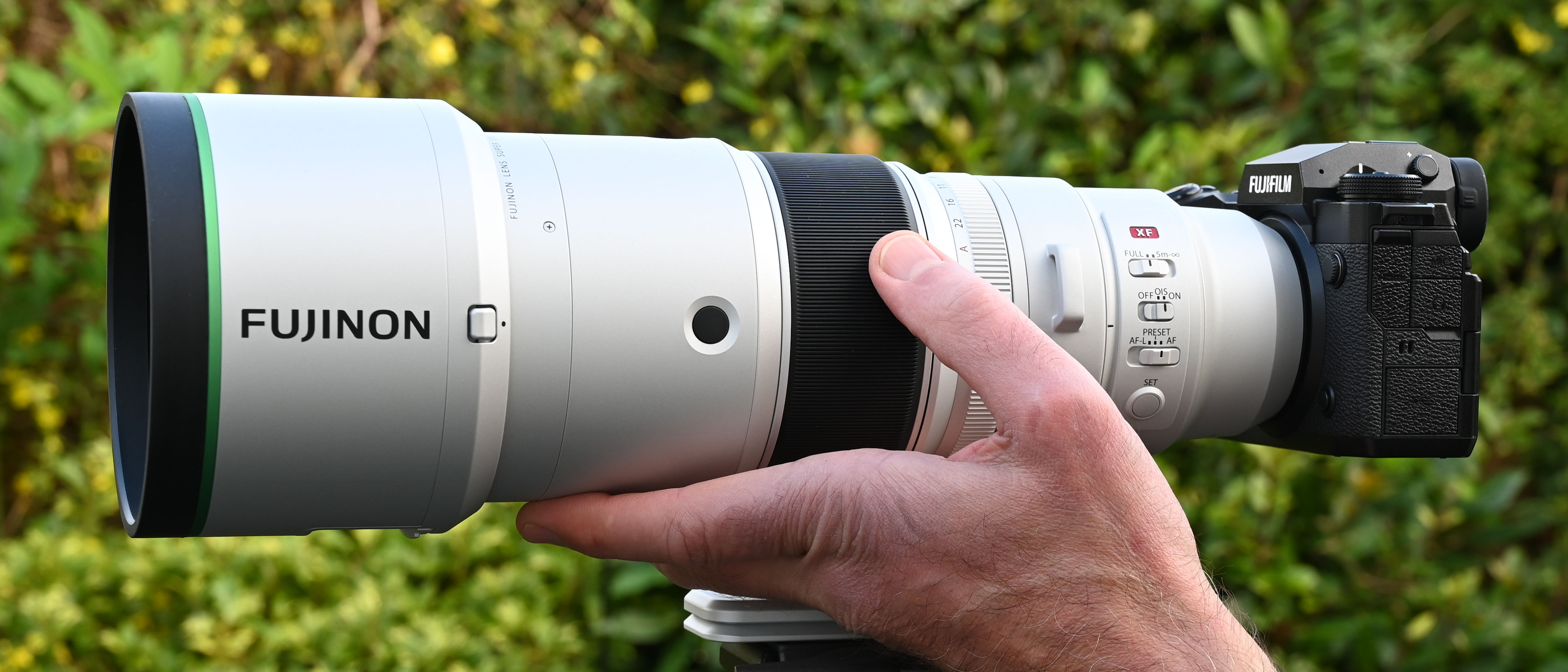
Fujifilm has been steadily building its APS-C format range of mirrorless X system cameras and lenses since 2011. With around 50 own-brand ‘Fujinon’ lenses currently available, plus a bunch more from independent lens manufacturers, there’s something to suit pretty much every need, budget and shooting scenario.
One gap in the line-up has so far been a really long super-telephoto prime lens. Sure, there are the rather excellent Fujifilm XF100-400mm f/4.5-5.6 R LM OIS WR and Fujifilm XF150-600mm F5.6-8 R LM OIS WR zoom lenses but, if you’re more into prime time, it’s been a long time coming.
Let’s see if the new XF500mm F5.6 R LM OIS WR is worth the wait. One thing’s for sure - the new lens aims for a spot as one of the best Fujifilm lenses for the X-T5 and other 40.2MP X cameras, as well as one of the best lenses for sports photography and best lenses for bird photography.

Fujifilm XF500mm F5.6 R LM OIS WR: Specifications
Fujifilm XF500mm F5.6 R LM OIS WR: Price
High-performance telephoto prime lenses are renowned for costing an absolute fortune. I’ve tested and reviewed plenty that cost about as much as a decent family car. A prime example, so to speak, is the Canon RF 800mm F5.6L IS USM with a price tag of around $17,000 / £19,000 / AU$27,999, well beyond the budget of most photographers.
This Fujifilm matches the Canon for aperture rating and, thanks to the APS-C format crop factor, it also comes very close in ‘effective’ focal length, at 762mm. That makes the Fujifilm prime look something of a bargain at $2,999 / £2,899 / AU$5,099 but there’s no denying it still costs a significant sum.
For further comparison, the Sigma 500mm F5.6 DG DN OS Sports for full-frame Sony and L-mount bodies was redesigned from the original DSLR-mount version of the lens, with a price drop from $5999 / £4699 to $2999 / £2779 / AU$4,799 in the process, more closely matching the price of the Fujifilm lens.
Fujifilm XF500mm F5.6 R LM OIS WR: Design & Handling
The Fujifilm XF500mm F5.6 R LM OIS WR looks an imposing lens, as I’d expect from a 500mm super-telephoto prime. It’s finished in (to my mind) an attractive shade of silver, although to some people, the color might be more reminiscent of relatively inexpensive cameras and kit zoom lenses from down the years.
Measuring 105x256mm, or 10.1 inches long, it’s pretty compact for this type of lens. More surprising is that it feels lighter than it looks, at 1335g (2.94lb). That makes it easily lightweight enough even for long periods of handheld shooting. That’s a bit plus point for me, given that the kinds of sports, wildlife and bird photography to which the lens is so well suited tend to come with long timescales.

Naturally, when you’re shooting handheld with a lens that has an effective 762mm focal length in full-frame terms, camera-shake is an ever-present danger. To combat this, the lens features a 5.5-stop optical image stabilizer. Unlike in many super-telephoto lenses, however, there’s no switch for selecting alternative static and panning stabilization modes.

To keep pace with the action, there’s a linear stepping motor-driven autofocus system. It’s typically near-silent as well as offering an excellent turn of speed. Fujifilm states an autofocus time of just 0.33 seconds, based on CIPA testing guidelines.

As a handling bonus, there are four function buttons featured around the forward section of the lens, spaced at 90-degree intervals so that they fall neatly under the thumb in any shooting orientation. They combine with a switch at the rear, for easily selecting AF-hold and AF-on functions, as well as for setting a focus distance preset. For a further speed boost in tricky conditions, you can stop autofocus hunting through its entire range of 2.7m to infinity with an AF range limiter switch that locks out the short end closer than 5m.

Good glass is a key factor for any lens. This one is based on 21 elements arranged in 14 groups and includes no less than five ED (Extra-low Dispersion) elements plus two Super ED elements. The aim is to optimize clarity, contrast and sharpness while minimizing color fringing and other aberrations.

With a fair chunk of the alphabet in its credentials, the lens is tagged R LM OIS WR. I’ve mentioned the Linear Motor and Optical Image Stabilizer already. The R signifies an aperture control ring, typical of up-market Fujifilm lenses. I like that it has a locking button, to avoid nudging it accidentally when controlling the aperture from the camera body. Also typical of Fujifilm, however, is that the ring has one-third f/stop click steps without a de-click option, which would be better when shooting video. WR stands for Weather-Resistant, the lens being fitted with Fujifilm’s typically extensive set of weather-seals.

Although not a heavyweight lens in the scale of things, the sturdy barrel features two strap lugs and is supplied with a shoulder strap as well as a carrying pouch. It’s certainly a whole lot easier to carry around than many monster super-telephoto primes that sometimes come with a big, weighty hard case. Also included is a color-matched circular hood, which includes a sliding panel for easy access to rotational filters like circular polarizers.

Fujifilm XF500mm F5.6 R LM OIS WR: Performance
I tested the lens with a flagship Fujifilm X-H2 camera body. It’s a natural match for this high-end prime and features a 40MP sensor, for which the lens has been designed. Squeezing that many megapixels onto an APS-C format image sensor demands great glass to make the most of the available resolution, as also featured in the Fujifilm X-T5 and Fujifilm X-T50 cameras.
The first thing that’s immediately obvious when you put your eye to the viewfinder is that the ‘effective’ 762mm focal length gives a real wow-factor in telephoto reach. It certainly covers the distance for bird photography, as well as for sports, wildlife and shooting at air shows when you can’t get as close as you might like.

And if all that reach still isn’t enough, the lens is compatible with the Fujifilm XF1.4x TC WR and Fujifilm XF 2.0x TC WR teleconverters for truly bonkers reach, with the usual one or two f/stop aperture reduction respectively. It’s maybe worth mentioning that the teleconverters come in stately black rather than the same blinging silver as the lens.
Right from the get-go, I was impressed with the lens’s autofocus speed and accuracy, as well as the effectiveness of the 5.5-stop optical stabilizer, which makes handheld shooting entirely viable despite the huge effective focal length. In my real-world tests, I found that sharpness lived up to expectations and truly did deliver the goods for Fujifilm’s 40MP image sensors. Meanwhile, bokeh is soft and dreamy, the combination of the focal length and f/5.6 aperture enabling a really tight depth of field in close to medium-range shooting.

Color fringing and distortion are basically non-issues, and the lens does very well to combat ghosting and flare. All in all, image quality is fabulous in all respects, while the exotic handling characteristics boost performance in practical terms.
Fujifilm XF500mm F5.6 R LM OIS WR: Sample Images
The following gallery of example shots were taken at the Bristol Floating Harbour in the South West of England, before moving on to Chew Valley Lake in Somerset for a bit of bird photography. I stuck with the widest available aperture of f/5.6 to gain as much shutter speed as possible to freeze any movement, without bumping up the camera’s sensitivity any more than necessary.


























Fujifilm XF500mm F5.6 R LM OIS WR: Lab Results
We run a range of lab tests under controlled conditions, using the Imatest Master testing suite. Photos of test charts are taken across the range of apertures and zooms (where available), then analyzed for sharpness, distortion and chromatic aberrations.
We use Imatest SFR (spatial frequency response) charts and analysis software to plot lens resolution at the center of the image frame, corners and mid-point distances, across the range of aperture settings and, with zoom lenses, at four different focal lengths. The tests also measure distortion and color fringing (chromatic aberration).
Sharpness:

The XF 500mm delivered some of its best lab results for sharpness when shooting wide-open at f/5.6, which is right where I’d want optimum performance. For an ultra-telephoto prime, sharpness is excellent in the central region of the frame and holds up really well towards the edges and corners.
Fringing:

Color fringing is very minimal, even out at the edges and corners of the frame. Technically, it gets a little worse as you stop down through the aperture range but, in real-world shooting, it’s virtually impossible to spot at any aperture.
Distortion: 0.22
There’s a very slight hint of pincushion distortion but, as with color fringing, this is only really perceptible in laboratory testing conditions and is basically a non-issue in real-world shooting.
Fujifilm XF500mm F5.6 R LM OIS WR: Verdict
I became an instant fan of the Fujifilm XF500mm F5.6 R LM OIS WR, as soon as I got it out of the box and picked it up. I much prefer handheld shooting for action, sports, wildlife and other super-telephoto scenarios, as I enjoy the greater freedom of movement than when using a tripod or monopod. I found this lens to be compact and lightweight enough for prolonged shooting sessions, unlike many 500mm primes that I’ve used in the past. Handling is excellent, autofocus is fast, optical stabilization is highly effective and image quality is drop-dead gorgeous. The lens is simply superb.

Should you buy the Fujifilm XF500mm F5.6 R LM OIS WR?
✅ Buy this...
- You want a super-telephoto prime for shooting action, sports, wildlife and subjects like birds and aircraft in flight.
- You want a long telephoto lens that’s light enough for prolonged handheld shooting, yet has pro-grade build and handling characteristics.
🚫 Don't buy this...
- You’d prefer the versatility of a zoom lens, which can also make it easier to ‘find’ erratic subjects like birds and aircraft before zooming in for the shot.
- You’d rather spend the big bucks on the super-fast Fujifilm XF 200mm F2 R LM OIS WR prime and use it with a Fujifilm XF 2.0x TC WR teleconverter for almost as much reach.







